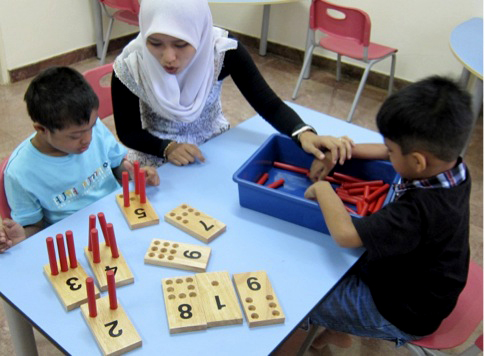Multiple Intelligence Classrooms at Taarana
The theory of multiple intelligences is a theory of intelligence that differentiates it into specific modalities rather than seeing intelligence as dominated by a single general ability. This model was proposed by Howard Gardner in his 1983 book Frames of Mind: The Theory of Multiple Intelligences.
Gardner chose eight abilities that he held to meet these criteria: musical–rhythmic, visual–spatial, verbal–linguistic, logical–mathematical, bodily–kinaesthetic, interpersonal, intrapersonal, and naturalistic.
Although the distinction between intelligences has been set out in great detail, Gardner opposes the idea of labelling learners to a specific intelligence. Each individual possess a unique blend of all the intelligences. Gardner firmly maintains that his theory of multiple intelligences should “empower learners”, not restrict them to one modality of learning.
Students with special needs and their intelligences:
Multiple intelligences theory work very well for students with special needs. Each student with special needs is unique. They are characterised by both their strengths and weaknesses. It is very important to teach them skills to overcome their weaknesses and is our duty to bring out their talents and tap in their strengths. As Gardner mentions intelligence cannot be measured as a single ability. It can be multiplied. Students with special needs often have special talents and savant skills which are their strengths. We need to work more on their talents to bridge the strengths and weaknesses.
What we do at Taarana:
At Taarana we aim at the holistic education. Equal opportunities are created for students to learn skills required for acquiring strengths and handling weaknesses. A typical day at Taarana now captures both components.
Each student is assessed on the different areas of intelligence and is placed in a particular intelligence area based on their strengths and interest. We have created booths where students will be placed to further hone their talents.
Vigorous training is provided in that particular area in which the student has strength so the students are well trained. At a later stage these training activities on multiple intelligences can pave a path to a career.
What we aim to achieve:
Training our students on functional skills and get them ready and independent is our aim. In order to achieve this we need provide varieties of learning opportunities to our students. Multiple intelligence activities will be a hands-on experience for our students to get exposed varied activities, varied learning experiences in varied settings.
We will utilise the multiple intelligence activities to have a career-based training activity for students who are in our upper classes.
Each area of intelligence as seen by Gardner is listed below.
Verbal-Linguistic Intelligence (Word Smart)
Description: Verbal-linguistic students love words and use them as a primary way of thinking and solving problems. They are good writers, speakers, or both. They use words to persuade, argue, entertain, and/or teach.
Logical-Mathematical Intelligence (Math Smart)
Description: Logical-mathematical students enjoy working with numbers. They can easily interpret data and analyse abstract patterns. They have a well-developed ability to reason and are good at chess and computer programming. They think in terms of cause and effect.
Spatial Intelligence (Picture Smart)
Description: Students strong in spatial intelligence think and process information in pictures and images. They have excellent visual receptive skills and excellent fine motor skills. Students with this intelligence use their eyes and hands to make artistic or creatively designed projects. They can build with Legos, read maps, and put together 1,000-piece jigsaw puzzles.
Musical Intelligence (Music Smart)
Description: Musical students think, feel, and process information primarily through sound. They have a superior ability to perceive, compose, and/or perform music. Musically smart people constantly hear musical notes in their head.
Bodily-Kinesthetic (Body Smart)
Description: Bodily-kinesthetic students are highly aware of the world through touch and movement. There is a special harmony between their bodies and their minds. They can control their bodies with grace, expertise, and athleticism.
Naturalistic Intelligence (Nature Smart)
Description: This intelligence refers to a person’s natural interest in the environment. These people enjoy being in nature and want to protect it from pollution. Students with strong naturalistic intelligence easily recognise and categorise plants, animals, and rocks.
Intrapersonal Intelligence (Self Smart)
Description: People with a strong intrapersonal intelligence have a deep awareness of their feelings, ideas, and goals. Students with this intelligence usually need time alone to process and create.

